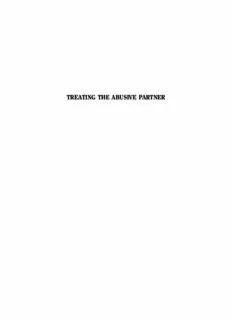
Treating the Abusive Partner: An Individualized Cognitive-Behavioral Approach PDF
Preview Treating the Abusive Partner: An Individualized Cognitive-Behavioral Approach
TREATING THE ABUSIVE PARTNER Treating the Abusive Partner An Individualized Cognitive-Behavioral Approach C M. M HRISTOPHER URPHY C I. E HRISTOPHER CKHARDT THE GUILFORD PRESS New York London ©2005TheGuilfordPress ADivisionofGuilfordPublications,Inc. 72SpringStreet,NewYork,NY10012 www.guilford.com Allrightsreserved Exceptasnoted,nopartofthisbookmaybereproduced,translated,storedina retrievalsystem,ortransmitted,inanyformorbyanymeans,electronic,mechanical, photocopying,microfilming,recording,orotherwise,withoutwrittenpermission fromthePublisher. PrintedintheUnitedStatesofAmerica Thisbookisprintedonacid-freepaper. Lastdigitisprintnumber: 9 8 7 6 5 4 3 2 1 LIMITEDPHOTOCOPYLICENSE Thesematerialsareintendedforuseonlybyqualifiedmentalhealthprofessionals. The Publisher grants to individual purchasers of this book nonassignable permis- sion to reproduce all materials for which photocopying permission is specifically grantedinafootnote.Thislicenseislimitedtoyou,theindividualpurchaser,foruse with your own clients and patients. It does not extend to additional clinicians or practicesettings,nordoespurchasebyaninstitutionconstituteasitelicense.This licensedoesnotgranttherighttoreproducethesematerialsforresale,redistribu- tion,oranyotherpurposes(includingbutnotlimitedtobooks,pamphlets,articles, video-oraudiotapes,andhandoutsorslidesforlecturesorworkshops).Permission toreproducethesematerialsfortheseandanyotherpurposesmustbeobtainedin writingfromthePermissionsDepartmentofGuilfordPublications. Murphy,ChristopherM.(ChristopherMark) Treatingtheabusivepartner:anindividualizedcognitive-behavioralapproach/ ChristopherM.Murphy,ChristopherI.Eckhardt. p.cm. Includesbibliographicalreferencesandindex. ISBN1-59385-207-X(cloth:alk.paper) 1. Abusivemen—Rehabilitation. 2. Abusivemen—Counselingof. 3. Wife abuse—Treatment. 4. Cognitivetherapy. I. Eckhardt,ChristopherI. II. Title. RC569.5.F3M872005 362.82′92—dc22 2005009026 AAbboouutt tthhee AAuutthhoorrss About the Authors Christopher M. Murphy, PhD, is Associate Professor of Psychology and directorofthedoctoralprograminclinicalpsychologyattheUniversityof Maryland, Baltimore County. Dr. Murphy also directs the New Behaviors ProgramattheDomesticViolenceCenterofHowardCounty,Maryland,a comprehensive clinical training, service, and research program focused on perpetrators of intimate partner violence. His research focuses on cognitive-behavioral and motivational treatments for abusive behavior in intimateadultrelationships,emotionalabuseinrelationships,andthelinks betweenintimatepartnerviolenceanduseofalcoholanddrugs.Thiswork has been supported by the National Institute of Mental Health and the National Institute on Alcohol Abuse and Alcoholism. Dr. Murphy has authoredmorethan40scientificarticlesandbookchaptersonthetopicof intimate partner violence. Christopher I. Eckhardt, PhD, is Associate Professor of Psychological Sci- encesatPurdueUniversityinWestLafayette,Indiana.Hisresearchfocuses on the cognitive, emotional, and behavioral characteristics of partner- abusive individuals, with a particular emphasis on anger and hostility in thispopulation.ThisworkhasbeensupportedbytheNationalInstituteof Mental Health, the National Institute on Alcohol Abuse and Alcoholism, theNationalInstituteofJustice,andtheHarryFrankGuggenheimFounda- tion. Dr. Eckhardt has authored more than 30 scientific articles and book chapters on the topic of intimate partner violence. v PPrreeffaaccee Preface I ntimate partner abuse is one of the most vexing social and public health problems in contemporary society. The obvious social costs include crimi- nal justice and legal interventions in abusive situations, shelter and advo- cacy services for victims, and medical care for injured parties. Even more importantaretheoftenhiddeneffectsonemotional,relationship,andfam- ily functioning. For example, partner abuse victimization is a significant factor in traumatic stress reactions, depression, and substance abuse. In addition, many child witnesses develop anxiety and stress reactions, con- duct problems, academic difficulties, and a repetitive cycle of coercive behavior in their own relationships. Partner abuse is a common contribut- ing factor to family instability, including relationship separation, divorce, family displacement, and homelessness. Onelogicalapproachtosocialinterventioninpartnerabuseistopro- vide counseling services for perpetrators. Over the last quarter century, overathousandsuchprogramshavebeendevelopedintheUnitedStates.A wide variety of program models and practices have emerged, ranging from didactic presentations about gender and power to group psychodynamic therapy. Yet, to date, no specific program model or intervention practice for partner-abusive individuals has strong research support for its efficacy. Indeed, given the limited empirical support for abuser intervention, some scholarshavequestionedwhethersuchprogramsshouldbeofferedatall. Our goal in this book is to propose and describe a new intervention approach for partner-abusive clients, an approach informed by current research on the causes and correlates of abusive behavior. Our approach beginswiththeobservationthatpartner-abusiveindividualsvarywidelyin vii viii Preface their presenting problems, readiness to change, and motivations for engag- inginabuse.Ratherthanprovidingastandard,one-size-fits-allgroupinter- vention, as is the typical practice in the field, we have spelled out a multi- phase, individual treatment for abusive individuals. The treatment described here has a number of important innovations relative to the standard practice in the field. First, an individualized case formulationguidestheselectionanddeliveryofinterventions.Theclinician is encouraged to carefully evaluate the nature and forms of abusive behav- ior, the conditions under which it occurs, its consequences, underlying beliefsandthinkingstylesthatpromoteabusivebehavior,andotherassoci- atedlifecomplicationsandproblems.Second,ourapproachisinfusedwith techniques designed to motivate change in resistant clients, promote a col- laborative working alliance, and apply directive interventions in a fashion designed to support a self-directed change process. Third, we provide a detailed presentation of cognitive and behavioral treatment strategies designed to undermine abuse-maintaining beliefs and hostile thinking pat- ternsandtopromoterelationshipskillsthatcansupplanttheneedforcoer- cive control. Finally, long-term change is addressed through a focus on traumarecoveryandrelapseprevention.Asfaraswecangather,thisisthe first comprehensive, individualized manual for the treatment of partner- abusive clients. It is important to acknowledge right from the outset that scientific research and clinical practice, as yet, have not provided sufficient answers to the key questions of why partner abuse occurs and what are the most effective means to change abusive behavior. In this book, we are equally interested in providing an impetus for future research on individualized intervention services for abusive clients as well as creating a guidebook for practitioners that is useful, comprehensive, up to date, and informed by available research and clinical experience. A book such as this, and the clinical and research efforts it represents, could not have been completed without the help of many important col- leagues and supporters. We would like to acknowledge support from the NationalInstituteofMentalHealthintheformofapsychosocialtreatment development grant (MH064562) to facilitate the specification and prelimi- naryinvestigationofthetreatmentoutlinedhere,andtotheNationalInsti- tute on Alcohol Abuse and Alcoholism, the National Institute of Justice, the Centers for Disease Control and Prevention, and the Maryland Gover- nor’s Office of Crime Control and Prevention, which have provided research support to one or both of us in our efforts to understand partner abuse and develop effective treatments for abusive clients. We would also like to acknowledge the consistent involvement of the agency staff at the Domestic Violence Center of Howard County, Maryland, including Judith Clancy, Jodi Finkelstein, Linda Meade, and Tori Shequine, who have pro- Preface ix vided Dr. Murphy with a remarkable context in which to conduct clinical research and training for over a decade. Finally, this work would not have been possible without the extensive involvement of current and former graduatestudentswhohaveservedasresearchcollaboratorsandtreatment providers, including Laura Lynch, Judy DeDeyn, Christina Watlington, Danielle Black, Fabio Van der Merwe, Casey Taft, Peter Musser, Tara Neavins, Jeff Elliott, Nancy Remington, Tanya Morrel, Jamie Winters, Theresa Schmitz, Marie Cugini, Stella Mantakos, Ashley Sibley, Bradley Norlander,andAngieUtschig.Specialthanksareduetoresearchtherapists whohavehelpedtorefineandtestouttheclinicalproceduresoutlinedhere, including Drs. Cindy Eaves, Andy Goode, Manu Singh, and Sharon Ste- phen. Finally, we would like to thank our mentors, K. Daniel O’Leary (C. M. M.) and Howard Kassinove (C. I. E.), who helped to instill in us the motivation and confidence to tackle this project.
